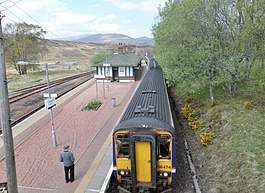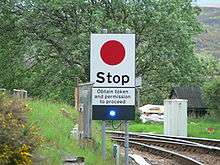Rannoch railway station
Rannoch railway station, on the West Highland Line, serves the area of Rannoch in Perth and Kinross, Scotland. Its remote location on Rannoch Moor is picturesque and makes it attractive to walkers. The station has a tea room and visitor centre. In 2017, Simon Jenkins reported it to be one of the best 100 stations in Britain.[3]
| Rannoch | |
|---|---|
| Scottish Gaelic: Raineach[1] | |
 Rannoch railway station viewed from the footbridge | |
| Location | |
| Place | Rannoch |
| Local authority | Perth and Kinross |
| Coordinates | 56.6859°N 4.5770°W |
| Grid reference | NN422578 |
| Operations | |
| Station code | RAN |
| Managed by | Abellio ScotRail |
| Number of platforms | 2 |
| Live arrivals/departures, station information and onward connections from National Rail Enquiries | |
| Annual rail passenger usage* | |
| 2014/15 | |
| 2015/16 | |
| 2016/17 | |
| 2017/18 | |
| 2018/19 | |
| History | |
| Key dates | Opened 7 August 1894 |
| Listed status | |
| Listing grade | Category B |
| Entry number | LB12245[2] |
| Added to list | 21 December 1988 |
| National Rail – UK railway stations | |
| * Annual estimated passenger usage based on sales of tickets in stated financial year(s) which end or originate at Rannoch from Office of Rail and Road statistics. Methodology may vary year on year. | |
Although the railway links the station with Glasgow and Fort William on the West Highland Line, the station area is otherwise more closely linked, by road, with central Highland towns and villages on or near the A9 road. The B846 road meets the A9 between Pitlochry and Blair Atholl, about 34 miles (55 km) east of the station.
History
.jpg)
When the West Highland Line was built across Rannoch Moor, its builders had to float the tracks on a mattress of tree roots, brushwood and thousands of tons of earth and ashes to prevent the heavy steel tracks sinking in the bog.
Rannoch station opened to passengers on 7 August 1894.[4]
The station was laid out with a crossing loop and an island platform. There were sidings on both sides, and a turntable on the east side of the line.[5] The siding on the east side has been removed. The station was host to a LNER camping coach from 1937 to 1939.[6]
On 25 January 1987, the crossing loop was altered to right-hand running. The original Down platform has thus become the Up platform, and vice versa. The change was made in order to simplify shunting at this station, by removing the need to hand-pump the train-operated loop points to access the sidings.
At the north end of the platform is a sculptured head, carved in stone by the navvies (workmen) who built the line. It commemorates James Renton, a director of the West Highland Railway, who gave part of his personal fortune to save the line from bankruptcy during construction when the brushwood raft was continually sinking into Rannoch Moor. (Thomas, 1965)
Signalling
The signal box, which had 17 levers, was situated on the island platform. From the time of its opening in 1894, the West Highland Railway was worked throughout by the electric token system.
In 1967, the method of working between Crianlarich and Rannoch was changed to the Scottish Region Tokenless Block system.

In August 1985, the method of working between Crianlarich and Rannoch reverted to the electric token block system. The semaphore signals were removed on 3 November 1985 in preparation for the introduction of Radio Electronic Token Block (RETB).
The RETB system was commissioned by British Rail between Upper Tyndrum and Fort William Junction on 29 May 1988. This resulted in the closure of Rannoch signal box and others on that part of the line. The RETB is controlled from a Signalling Centre at Banavie railway station.
The Train Protection & Warning System was installed in 2003.
There was formerly another crossing point on Rannoch Moor, at Gorton Crossing[7] near where the railway crossed the Rannoch Drove Road, and operationally dividing the long section between Bridge of Orchy and Rannoch stations. It remains today as an engineer's siding but devoid of the original buildings.
Services
Monday to Saturday, northbound, Rannoch has three services to Mallaig and one service to Fort William (Highland Caledonian Sleeper). Southbound, there are three services to Glasgow Queen Street and one service to London Euston (Highland Caledonian Sleeper, Saturdays excepted). The sleeper also carries seated coaches and can therefore be used by regular passengers to/from Edinburgh Waverley and Glasgow Queen Street (Low Level) as it is booked to pick up/set down at both stations.[8]
On Sundays, there is just one service northbound to Mallaig all year, plus a second between May and late October; one service southbound to Glasgow Queen Street (two in summer) and one service (Highland Caledonian Sleeper) to London Euston.
| Preceding station | Following station | |||
|---|---|---|---|---|
| Bridge of Orchy | Abellio ScotRail West Highland Line |
Corrour | ||
| Bridge of Orchy | Caledonian Sleeper Highland Caledonian Sleeper |
Corrour | ||
| Historical railways | ||||
| Gorton | North British Railway West Highland Railway |
Corrour | ||
See also
References
- Brailsford, Martyn, ed. (December 2017) [1987]. "Gaelic/English Station Index". Railway Track Diagrams 1: Scotland & Isle of Man (6th ed.). Frome: Trackmaps. ISBN 978-0-9549866-9-8.CS1 maint: ref=harv (link)
- Historic Environment Scotland. "RANNOCH STATION INCLUDING SIGNAL BOX AND SCULPTURED PORTRAIT OF JAMES RENTON (LB12245)". Retrieved 15 April 2019.
- https://www.theguardian.com/travel/2017/oct/01/10-of-the-best-railway-stations-in-britain-uk-simon-jenkins
- Quick, Michael (2019) [2001]. Railway passenger stations in Great Britain: a chronology (PDF) (5th ed.). Railway and Canal Historical Society.
- "Rannoch station on OS Six-inch map Argyll and Bute Sheet XXXIV.SW (includes: Fortingall; Lismore and Appin)". National Library of Scotland. 1900. Retrieved 8 June 2020.
- McRae (1997), page 11
- (grid reference NN 395 479 - still marked on OS maps
- Table 227 National Rail timetable, May 2016
- McRae, Andrew (1997). British Railway Camping Coach Holidays: The 1930s & British Railways (London Midland Region). Scenes from the Past: 30 (Part One). Foxline. ISBN 1-870119-48-7.
- Thomas, John (1965). The West Highland Railway. Newton Abbot: David and Charles (Publishers) Ltd. ISBN 0-7153-7281-5.
External links
| Wikimedia Commons has media related to Rannoch railway station. |